|
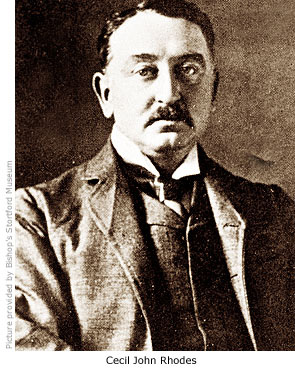 Cecil John Rhodes was born 5 July 1853 at Netteswell House, a three-storey semi-detached Georgian property in South Street. His father, Rev Francis William Rhodes (1807–1878), had previously been Curate of the parish of Brentwood in Essex (1834–1849) but moved to Bishop’s Stortford in 1849 to become the Vicar of St Michael’s Church. Cecil John Rhodes was born 5 July 1853 at Netteswell House, a three-storey semi-detached Georgian property in South Street. His father, Rev Francis William Rhodes (1807–1878), had previously been Curate of the parish of Brentwood in Essex (1834–1849) but moved to Bishop’s Stortford in 1849 to become the Vicar of St Michael’s Church.
Twice married, he had a daughter named Elizabeth by his first wife and two daughters and nine sons by his second, Louisa Peacock Rhodes (1816–1873) who he married in 1844. The daughters were born in Braintree, Essex but all nine sons, two of whom died in infancy, were born in Bishop’s Stortford. Shortly after the birth of Cecil – the 5th born son – the family moved out of Netteswell into the adjoining house called Thorley Bourne.
Both houses were built in the 1830s by the Death family, who lived in Netteswell before renting the property to Rev Rhodes. The reason Rhodes moved here in the first place was his re-establishment of the town’s grammar school, and the fact that he let the Church Street vicarage be used as temporary accommodation by headmaster and pupils while it was being built (See Guide 15 – Church Street). When the family moved into Thorley Bourne, Netteswell was accommodated by the Rhodes's 10 servants.
|
|
The young Cecil Rhodes was a sickly boy with fair curly hair, piercing eyes and a squeaky, almost ‘girlish’ voice. He spent most of his formative years wandering around Bishop’s Stortford, usually on his own, or sitting idle in the garden of the family home. The remainder of his time was spent attending the High School built by his father in the High Street (See Guide 3), and though not a great academic he had an interest in history and classics. He also enjoyed games and played cricket for the school XI at the age of thirteen.
By the time he left school in 1869, aged fifteen, he had attained a classics prize and first-class honours in the Cambridge Local Examination. His six brothers also attended the High School, two of them going on to Public school and the other four becoming soldiers, two of whom won the D.S.O..
For the next eighteen months Cecil studied under his father, who always expected him and his brothers to take part in parish work and attend regularly services at St Michael’s. Cecil also taught in Sunday school helping his mother with Bible classes. His character was doubtlessly formed in boyhood by both his parents but it was the personality of his mother, who never failed to give him encouragement and affection, that probably helped him most in his future career. His father wanted him to go into holy orders but Cecil’s preference was to become a barrister, which even his usually supportive mother was opposed to.
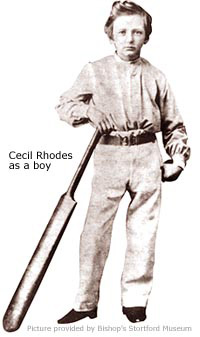 The solution to the problem came in the form of a letter from his older brother, Herbert*, who had earlier gone to South Africa and successfully established himself as a cotton farmer in the British colony of Natal. He invited Cecil to join him, and on the 21 June 1870, at the age of sixteen, he embarked on a 72-day journey in an old wooden sailing ship called the Eudora. The solution to the problem came in the form of a letter from his older brother, Herbert*, who had earlier gone to South Africa and successfully established himself as a cotton farmer in the British colony of Natal. He invited Cecil to join him, and on the 21 June 1870, at the age of sixteen, he embarked on a 72-day journey in an old wooden sailing ship called the Eudora.
Arriving in Durban shortly after his seventeenth birthday his brother failed to meet him, having earlier that year joined a group of English adventurers and headed for the newly found diamond fields of the lower Vaal. They had some success there and were instrumental in uncovering the first major ‘river diggings’ site at Klip Drift in March 1870. Herbert returned to Natal one month after Cecil had arrived at his farm.
Unperturbed by his brother’s initial absence, Cecil quickly adapted to life as a cotton farmer and for the next six months both he and his brother worked hard to improve the homestead and farm. But Herbert soon grew restless and returned to the diamond fields in March 1871, leaving Cecil to supervise the cotton harvest. By July of that year Herbert was staking out claims at the rich diamond mine newly discovered in Colesberg Kopje – later renamed Kimberley after the British Secretary of State for the Colonies, Lord Kimberley. This was to prove the richest diamond mine in the world.
|
|
Back in Natal, Cecil realised the cotton boom was coming to an end and knew he'd stand a far better chance of making his fortune if he joined his brother in the diamond fields. He set off on the 400 mile trek to join him in October 1871, but when his pony died along the way he walked the remaining distance, covering about fourteen miles a day. He finally arrived there in November.
Conditions at Kimberley were primitive and difficult but Cecil’s innovative mind soon introduced many new ideas to improve things, including a steam pump that made mining more productive. He formed a partnership with Charles Rudd and became involved in a number of business enterprises, but it was always his aim to consolidate the diamond industry under his own control.
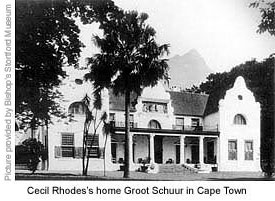 That goal was eventually achieved with the establishment of the De Beer Mining Company, later to become De Beers Consolidated Mines. The name De Beers was derived from Johannes Nicholas De Beer, one of two brothers who owned the farm Vooruitzicht on which the Kimberley mines were discovered. Having bought the farm in 1860 from the government for £50, they had no hesitation in selling it in 1871 to a syndicate for £6,300. History soon forgot the brothers but the name De Beer lives on as one of the world’s biggest and well known companies, still controlling about 70% of the diamond market. That goal was eventually achieved with the establishment of the De Beer Mining Company, later to become De Beers Consolidated Mines. The name De Beers was derived from Johannes Nicholas De Beer, one of two brothers who owned the farm Vooruitzicht on which the Kimberley mines were discovered. Having bought the farm in 1860 from the government for £50, they had no hesitation in selling it in 1871 to a syndicate for £6,300. History soon forgot the brothers but the name De Beer lives on as one of the world’s biggest and well known companies, still controlling about 70% of the diamond market.
Within three years Cecil amassed for himself a considerable fortune and in 1873 returned to Bishop’s Stortford a wealthy young man. His yearning to study for a degree was briefly curtailed when he failed to gain admittance to University College Oxford, but after an interview with Edward Hawkins, Provost of Oriel College, he was accepted and started his degree course that same year.
|
|
It was during his first term at Oriel College that his mother died, aged 57; an event that devastated Cecil. After her burial in St Michael’s churchyard (See Guide 14), he resumed his studies at Oxford with the intention of continuing terms there, but in January 1874 the lure of South Africa was too much and he returned to Kimberley to set about the business of making money.
Two years later he returned to England to resume his studies at Oxford, and while there it is said he was initiated into a Masonic order, moving him to write his Confessions of Faith, which outlined his own desire to establish a secret society.
That same year he visited his father who was now living back at the vicarage with his remaining family. All seemed well, but the following year Rev Rhodes resigned his position as Vicar of the parish and went to live near Hastings in Sussex. He insisted it was infirmity and old age that made him resign, but his constant quarrels with churchwardens was common knowledge.
Rev Rhodes died in 1878, and Cecil, who had now finished his studies at Oxford, returned to Bishop’s Stortford for the very last time. But it was not a goodwill visit. His anger at the way the town had treated his father after all he had done for it was so intense, he cut all ties with his birthplace and never referred to Bishop’s Stortford again. He returned to England in 1881 to complete his final term at Oxford and take his pass degree.
On his return to Kimberly he found that his joint interest with partner Charles Rudd had, by now, become extremely successful and he was rapidly becoming one of the wealthier men in Kimberley. Wanting to combine his wealth with political power, he stood for election to the Cape Legislative Assembly, which he successfully entered in 1881.
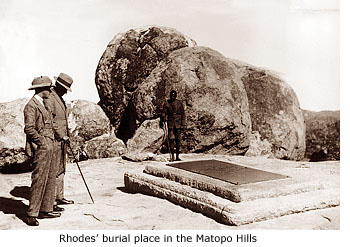 This position enabled him to pursue his dream of northern expansion to the Zambesi River and beyond, with the intention of forming a north-south swathe of British-orientated territory extending to the border of Egypt, thereby enabling rail and telegraph networks between the Cape and Cairo. In the coming years his plan of British rule was partially implemented, although the telegraph line and railway were thwarted by imperial politics and cost. This position enabled him to pursue his dream of northern expansion to the Zambesi River and beyond, with the intention of forming a north-south swathe of British-orientated territory extending to the border of Egypt, thereby enabling rail and telegraph networks between the Cape and Cairo. In the coming years his plan of British rule was partially implemented, although the telegraph line and railway were thwarted by imperial politics and cost.
In 1886, gold was discovered south of Pretoria in an area called Witwatersrand (white water’s ridge), which proved to be the richest deposit of gold the world had ever seen. It became known as ‘the Rand’ and within a few years a city named Johannesburg grew up around the gold field. Rhodes initial reluctance to get involved in gold mining soon disappeared and he formed Consolidated Goldfields of South Africa – a company that is still as pre-eminent in gold as De Beers is in diamonds. At the age of thirty-five he was, arguably, the richest man in the western world, and in 1889 formed the British South Africa Company for which he received a Royal Charter signed by Queen Victoria.
In 1890 Cecil Rhodes reached the peak of his political career by being elected Prime Minister of the Cape Colony, and in 1893 he founded Rhodesia. But his ultimate aim at this time was to take control of the two neighbouring Boer republics, and that was to be his downfall. He conspired to overthrow the government of Paul Kruger, and after being implicated in the disastrous Jameson Raid on the neighbouring Transvaal Republic, all support was withdrawn and he resigned as premier in 1896.
In 1897 the British Parliament censured him for breaches of duty, after which he devoted his time to the development of the country that had been named Rhodesia (now Zimbabwe) in his honour that same year.
The final years of his life were fraught with ill health and marred by native rebellions in the Rhodesian territories. This, along with the deteriorating relationships with the Afrikaners, eventually led to the Boer War in 1899. Ever since the 1870s, when he’d suffered two heart attacks, Rhodes had had premonitions of an early death. As his heart weakened in 1901 he decided to return to England and booked a boat passage. But his health steadily declined, and on 26 March 1902 he died at Muizenberg, aged 48. On his deathbed he is said to have uttered his final words, ‘So little done, so much to do’.
As Rhodes lay in state at his 17th century Cape Town home, Groote Schuur (The Great Granary), more than 30,000 residents filed past his coffin to pay their final respects. His body was then moved to Bulawayo for another laying in state and funeral, and finally he was taken to be buried in the Matopo Hills, Rhodesia – known as ‘View of the World’ and the traditional burial place of African Chiefs. It is said a team of 1,000 Matabele carved a 25km route through rocky terrain for his cortege and that his grave was excavated out of solid granite rock.
His epitaph, written by friend and poet Rudyard Kipling, is inscribed on the memorial: 'The immense and brooding spirit still shall quicken and control, Living he was the land and dead his soul shall be her soul.'
Mark Twain wrote of him: 'When he stood upon the Cape Peninsula, his shadow fell on the Zambeezi'.
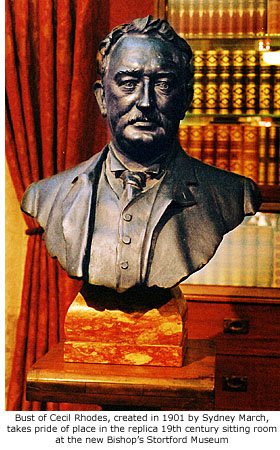 Contrary to Bishop's Stortford's past view of Rhodes's achievements in South Africa, there he is revered as a successful entrepeneur, businessman and benefactor. A Rhodes Memorial stands on the slopes of Devil’s Peak, alongside Table Mountain in Cape Town, and his image is remembered by two statues; one in Zimbabwe and one in Harare – the latter being damaged. A plan in the early 1990s to 'bring home' the statue from Zimbabwe was curtailed when the authorities said it wanted to keep the bronze likeness in a Bulawayo museum garden. The only other statue to exist is in three pieces, kept at Oxford where Rhodes studied. Contrary to Bishop's Stortford's past view of Rhodes's achievements in South Africa, there he is revered as a successful entrepeneur, businessman and benefactor. A Rhodes Memorial stands on the slopes of Devil’s Peak, alongside Table Mountain in Cape Town, and his image is remembered by two statues; one in Zimbabwe and one in Harare – the latter being damaged. A plan in the early 1990s to 'bring home' the statue from Zimbabwe was curtailed when the authorities said it wanted to keep the bronze likeness in a Bulawayo museum garden. The only other statue to exist is in three pieces, kept at Oxford where Rhodes studied.
His former 'cottage' holiday home in Muizenberg is now a museum and place of pilgrimage, and his one-time home, Groote Schuur, is currently the official residence of the state president.
Cecil Rhodes's fortune was vast and in his will he left over £3 million to Oxford University to establish the *Rhodes scholarship trusts; enabling overseas students to attend the university and so promote ‘the union of the English-speaking people throughout the world’. He left nothing to his half-sister, Elizabeth, or to his old school in Bishop’s Stortford, although the Rhodes Trust did later provide two scholarships to the College worth £20 a year.
His resentment towards the town of his birth left its mark and was possibly the reason why Bishop’s Stortford itself did very little to proclaim its part in the life of this great Englishman in the years following his death. Before the Rhodes Centre was built in 1963, no public statue or portrait existed here to recall the features of either Cecil Rhodes or his father. The only memorial to Rev Rhodes is a stained glass window in the tower of St Michael's. In the same church a bronze tablet recording his son’s brief life, was at first placed in the chancel but later 'relegated' to the wall of the north aisle. At Netteswell House in South Street, a large plaster tablet was placed high on the wall of the house recording the fact that he was born in the room within.
A county memorial was actually proposed soon after his death and large sums of money were promised to the committee formed to oversee it. However, a difference of opinion soon emerged within the committee resulting in several members resigning and many subscriptions being cancelled. The remaining fund stood at almost £3,000 and after advice from Lord Kitchener it was decided to use the money to build a Drill Hall. This was erected in 1906 to the south-west of the Market Square and still stands today (See Guide 2). There is, however, no mention, inside or out, of Cecil Rhodes.
*Each year 90 scholars from former and present commonwealth countries, as well as the USA, are given Rhodes scholarships. Perhaps the most prominent recipient of a scholarship was former President of the United States, Bill Clinton, who studied Government at Oxford University between 1968 and 1970.
*Herbert Rhodes spent a short term in prison for gun-running and died in 1879, aged just 34. While pouring out a large bottle of home-brewed gin in his hut, an ember from his pipe ignited the spirit and caught his clothes alight. He threw himself into a nearby river to quench the flames but died shortly after.
|


 Cecil John Rhodes was born 5 July 1853 at Netteswell House, a three-storey semi-detached Georgian property in South Street. His father, Rev Francis William Rhodes (1807–1878), had previously been Curate of the parish of Brentwood in Essex (1834–1849) but moved to Bishop’s Stortford in 1849 to become the Vicar of St Michael’s Church.
Cecil John Rhodes was born 5 July 1853 at Netteswell House, a three-storey semi-detached Georgian property in South Street. His father, Rev Francis William Rhodes (1807–1878), had previously been Curate of the parish of Brentwood in Essex (1834–1849) but moved to Bishop’s Stortford in 1849 to become the Vicar of St Michael’s Church. The solution to the problem came in the form of a letter from his older brother, Herbert*, who had earlier gone to South Africa and successfully established himself as a cotton farmer in the British colony of Natal. He invited Cecil to join him, and on the 21 June 1870, at the age of sixteen, he embarked on a 72-day journey in an old wooden sailing ship called the Eudora.
The solution to the problem came in the form of a letter from his older brother, Herbert*, who had earlier gone to South Africa and successfully established himself as a cotton farmer in the British colony of Natal. He invited Cecil to join him, and on the 21 June 1870, at the age of sixteen, he embarked on a 72-day journey in an old wooden sailing ship called the Eudora. That goal was eventually achieved with the establishment of the De Beer Mining Company, later to become De Beers Consolidated Mines. The name De Beers was derived from Johannes Nicholas De Beer, one of two brothers who owned the farm Vooruitzicht on which the Kimberley mines were discovered. Having bought the farm in 1860 from the government for £50, they had no hesitation in selling it in 1871 to a syndicate for £6,300. History soon forgot the brothers but the name De Beer lives on as one of the world’s biggest and well known companies, still controlling about 70% of the diamond market.
That goal was eventually achieved with the establishment of the De Beer Mining Company, later to become De Beers Consolidated Mines. The name De Beers was derived from Johannes Nicholas De Beer, one of two brothers who owned the farm Vooruitzicht on which the Kimberley mines were discovered. Having bought the farm in 1860 from the government for £50, they had no hesitation in selling it in 1871 to a syndicate for £6,300. History soon forgot the brothers but the name De Beer lives on as one of the world’s biggest and well known companies, still controlling about 70% of the diamond market. This position enabled him to pursue his dream of northern expansion to the Zambesi River and beyond, with the intention of forming a north-south swathe of British-orientated territory extending to the border of Egypt, thereby enabling rail and telegraph networks between the Cape and Cairo. In the coming years his plan of British rule was partially implemented, although the telegraph line and railway were thwarted by imperial politics and cost.
This position enabled him to pursue his dream of northern expansion to the Zambesi River and beyond, with the intention of forming a north-south swathe of British-orientated territory extending to the border of Egypt, thereby enabling rail and telegraph networks between the Cape and Cairo. In the coming years his plan of British rule was partially implemented, although the telegraph line and railway were thwarted by imperial politics and cost. Contrary to Bishop's Stortford's past view of Rhodes's achievements in South Africa, there he is revered as a successful entrepeneur, businessman and benefactor. A Rhodes Memorial stands on the slopes of Devil’s Peak, alongside Table Mountain in Cape Town, and his image is remembered by two statues; one in Zimbabwe and one in Harare – the latter being damaged. A plan in the early 1990s to 'bring home' the statue from Zimbabwe was curtailed when the authorities said it wanted to keep the bronze likeness in a Bulawayo museum garden. The only other statue to exist is in three pieces, kept at Oxford where Rhodes studied.
Contrary to Bishop's Stortford's past view of Rhodes's achievements in South Africa, there he is revered as a successful entrepeneur, businessman and benefactor. A Rhodes Memorial stands on the slopes of Devil’s Peak, alongside Table Mountain in Cape Town, and his image is remembered by two statues; one in Zimbabwe and one in Harare – the latter being damaged. A plan in the early 1990s to 'bring home' the statue from Zimbabwe was curtailed when the authorities said it wanted to keep the bronze likeness in a Bulawayo museum garden. The only other statue to exist is in three pieces, kept at Oxford where Rhodes studied.